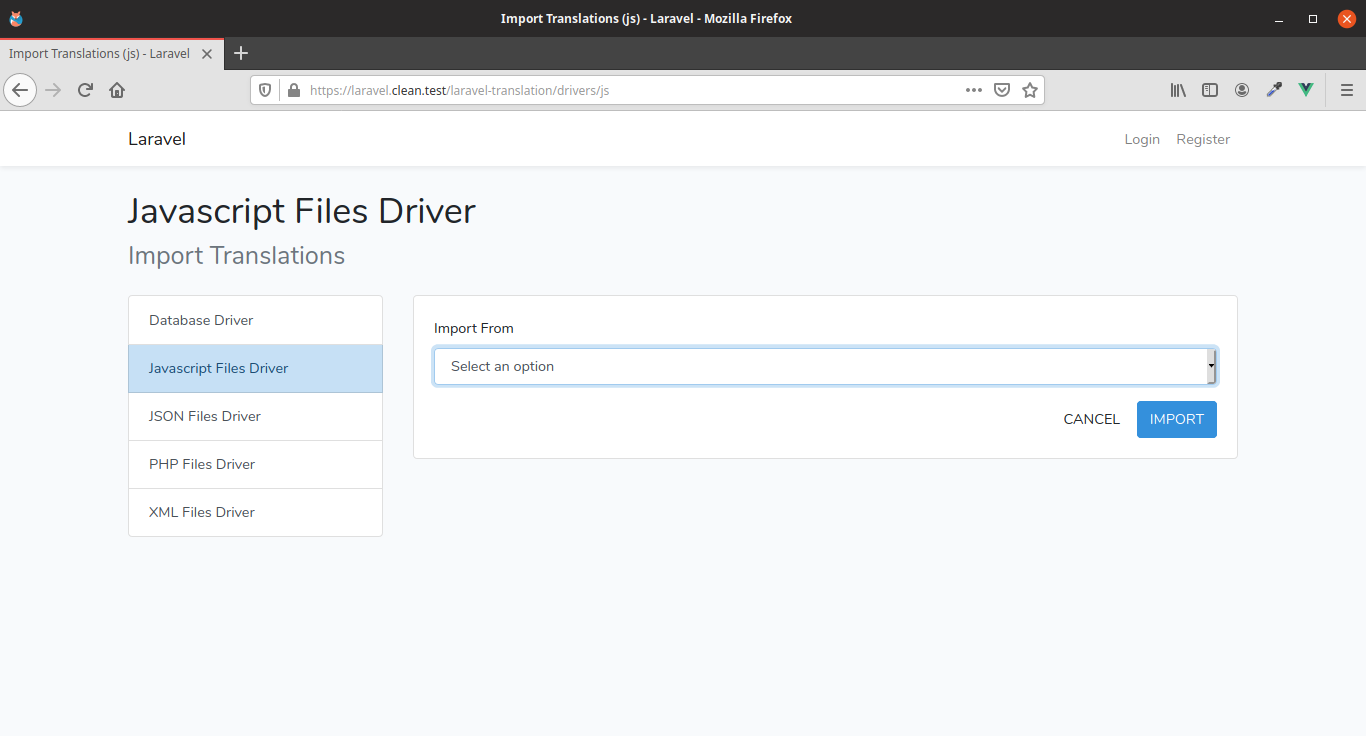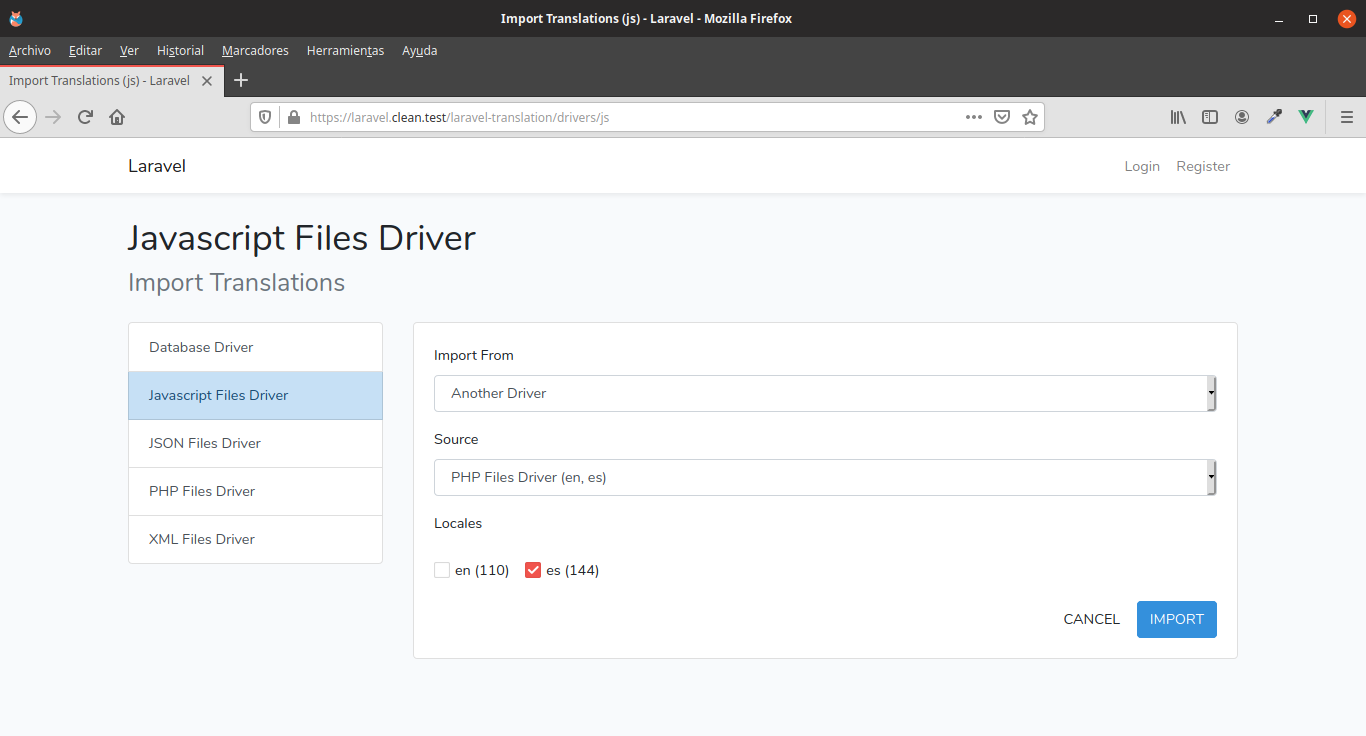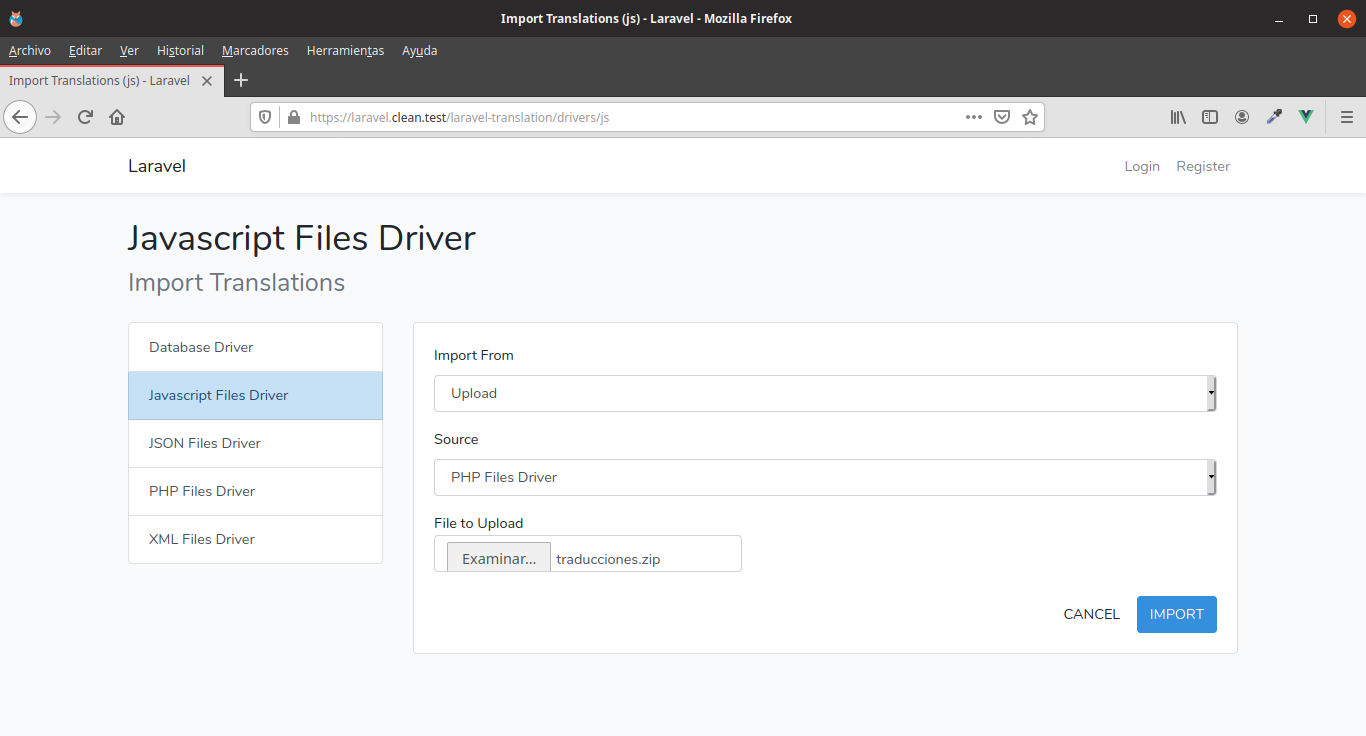sluy / laravel-translation
Manage your translation in the correct way with Laravel. Export and import to another formats, do things in most used frontend Frameworks and more!.
Installs: 1
Dependents: 0
Suggesters: 0
Security: 0
Stars: 0
Watchers: 1
Forks: 0
Open Issues: 0
pkg:composer/sluy/laravel-translation
Requires
- php: ^7.1
- illuminate/support: 5.8.*|^6.0
Requires (Dev)
- orchestra/testbench: 3.8.*
- phpunit/phpunit: ^7.0
This package is auto-updated.
Last update: 2026-01-09 11:31:56 UTC
README
Store your translation files in different formats (database, json, js, xml, php ) with a single command.
We know it, Laravel is very powerfull and the titan in Php Frameworks; however, some consistence in it is very squishy, for example, Translations.
You have a single files for translations and you can edit it simply and faster, but... When you make a SPA ? Vue app? Where stay a robust interface to manage translations? This is the start of the problem.
We create an easy commands to manipulate translations in different formats and generated a simple class (Vanilla JS and Vue.js at the moment) to load it in frontend apps.
Thats is all, format conversions and single functions to translate in front, who needs more with Laravel?
Another "db translations" for Laravel?
No, never.
Some libraries (well, the vast majority) offers to you a bridge to use Db in Translations (in some cases it will replaces Laravel translation) + any loader + some things and bumb: another db translations library.
We offers next level of "comfort" : Manage all the translations of you need and enjoy all the "things" to do with that.
Installation
You can install the package via composer:
composer require sluy/laravel-translation
You could publish migrations, configuration and translations for views with:
php artisan vendor:publish --provider="Sluy\LaravelTranslation\LaravelTranslationServiceProvider"
Configuration
With some configurations (or none in many cases) you can perform all package functions:
//config/laravel-translation.php <?php return [ // Determines if language will be autodetected on request. // If this option are enabled it will use 'Accept-Language' http header // to lookup. 'autodetect_language' => true, // An array with package drivers. 'drivers' => [ // Db driver: Store/Retrieve data from Database. 'db' => [ 'class' => Sluy\LaravelTranslation\Drivers\Common\DbDriver::class, 'location' => 'translations', // Default table to work 'connection' => null, // null for default connection ], // Php driver: Store/Retrieve data from default Laravel php location files. 'php' => [ 'class' => Sluy\LaravelTranslation\Drivers\Common\PhpDriver::class, 'location' => resource_path('lang'), ], // JS driver: Store/Retrieve data in Js Modules format. Common of VanillaJs/VueJS // apps works with this 'js' => [ 'class' => Sluy\LaravelTranslation\Drivers\Common\JsDriver::class, 'location' => storage_path('laravel_translation/lang/js'), // determines if will generate index.js files when store/delete items 'generate_index' => true, // determines if npm will reload files when store/delete items 'npm_reload' => true, ], // Json driver: Store/Retrieve data in JSON format. You can perform, for example, // remote fetches of translations. 'json' => [ 'class' => Sluy\LaravelTranslation\Drivers\Common\JsonDriver::class, 'location' => storage_path('laravel_translation/lang/json'), ], // Xml driver: Store/Retrieve data in XML format. Yes, we know, XML doesnt seems // like a "popular" format, but it have too!. 'xml' => [ 'class' => Sluy\LaravelTranslation\Drivers\Common\XmlDriver::class, 'location' => storage_path('laravel_translation/lang/xml'), ], ], ];
Commands
Importing/Exporting translations
Common way to generate translations in multiple formats. Basically from one formato to another format, thats is all.
php artisan laravel-translation:import {src_driver} {dst_driver} --locale= --dst_location= --src_location=
Basically, we have this:
| name | required | |
|---|---|---|
dst_driver |
Name of destination driver. | yes |
src_driver |
Name of source driver. | yes |
locale |
Locales to export (separated with comma). If this value doesnt setted, it will export all languages. | no |
dst_location |
Location of Destination driver data. If this value doesnt setted, it will take automatically location setted for the driver in config/laravel-translation.php file. |
no |
src_location |
Location of Source driver data. If this value doesnt setted, it will take automatically location setted for the driver in config/laravel-translation.php file. |
no |
Example
php artisan laravel-translation:import {db} {php} --locale=es,en --dst_location=my_custom_translations src_location=/my_custom_folder/php
It will import PHP files in /my_custom_folder/php to Database table called my_custom_translations.
Destroying translations
You can destroy any translation resource exporting alike:
php artisan laravel-translation:destroy {driver} -locale= --location=
Basically, we have this:
| name | required | |
|---|---|---|
driver |
Name of driver. | yes |
locale |
Locales to delete (separated with comma). If this value doesnt setted, it will delete all languages resources from driver. | no |
| location | Location of driver resources. If this value doesnt setted, it will take automatically location setted for the driver in config/laravel-translation.php file. |
no |
Example
php artisan laravel-translation:destroy {json} --locale=es --location=/my_custom_folder/json
It will destroy es locales in /my_custom_folder/json.
GUI Administration
Our package includes all in one GUI to do all command things (and a little bit more) with a graphical interface.
Adding views
You can and GUI views with artisan command:
php artisan laravel-translation:views {format} --rewrite=true/false
| name | description | required |
|---|---|---|
format |
Format of view markup. You can set as:html : Standalone GUI Version. It includes bootstrap markup included with cdn source.bootstrap: Uses laravel ui boostrap templates. Extends app.layout automatically. |
yes |
rewrite |
Determines if view files will be rewriten if exists. Default false |
no |
GUI Views are stored in resources/vendor/laravel-translation path and resets Laravel View Cache automatically.
Example
php artisan laravel-translation:views html --rewrite=true
Adding routes
To add package routes type in your project root:
php artisan laravel-translation:routes
It will add all needed routes to your web.php and api.php
If you want to deploy web or api routes only, you can define only optional parameter:
php artisan laravel-translation:routes --only=web #only deploys "web" routes php artisan laravel-translation:routes --only=api #only deploys "api" routes
Web Manager
Driver Management
laravel-translation/drivers route will show all administrative topics for your defined drivers
Basically, it show available drivers in boxes with:
- Driver name
- Driver info
- Location of "store" resource
- Current loaded locales (with x control to remove module locale translations)
- Actions
- import : Open import interface.
- clear: To remove all translations.
Importing Data
laravel-translation/drivers/{driver} route will allow to import translations to current {driver}.
First of all, you will need to choose if you want an importation from another driver or an upload.
From another Driver
After choosing Another Driver option, it will show you another necessary controls:
- Source: Defines source driver to import data.
- Locales: Check desired locales to import.
From upload
Yes, you can upload translations from your computer!
When you pick Upload options, it will needs to fill:
- Source: Source format (aka driver) of upload.
- File to upload: A zip file with all the translations structure. Translation structure is the same thing than Laravel translation folder
resources/lang.
Helpers
Javascript Helper
You can add a simple helper to translate directly in Javascript (very usefull in SPA development):
php artisan laravel-translation:helpers js --bootstrap=true/false
boostrap option will determines if you want to add automatically helper in resources/js/bootstrap.js file. By default their value is false.
After typing javascript helper installer command (and added it in bootstrap) you can easily translate words:
__('your.keyword', {replace1: 'value1', replace2: 'value2', ...});
VueJS Extension
We does not forgot lovely VueJS framework. You can add VueJS helper with command:
First at all, you need to install Javascript Helper to works with Vue Extension:
php artisan laravel-translation:helpers js --bootstrap=true
After that, install Vue Extension :
php artisan laravel-translation:helpers vue --bootstrap=true/false
As in previous case, boostrap option will determines if you want to add automatically helper in resources/js/bootstrap.js file. By default their value is false.
After installing VueJS helper, you can use translations inside templates:
<template> <div> <div> {{__('your.keyword')}} </div> </div> </template>
Or inside logic definition:
export default { mounted () { this.__('your.keyword'); } }
Additionally, VueJS Extension injects a directive to translate directly in your templates:
<template> <div> <div v-trans="'your.keyword'"></div> <!-- or... --> <div trans>your.keyword</div> </div> </template>
Additional Notes
Give Right privileges to Driver files/folders location
Remember to provide read/write access to driver or it will fires access errors.
For example with PHP Driver:
sudo chown -R youruser:www-data resources/lang sudo chmod -R 775 resources/lang
Changelog
Please see CHANGELOG for more information what has changed recently.
Contributing
Please see CONTRIBUTING for details.
Security
If you discover any security related issues, please email sluy1283@gmail.com instead of using the issue tracker.
Credits
License
The MIT License (MIT). Please see License File for more information.




